Friday, January 8, 2010
New year, new site
www.localappetiteny.com
I'll see you over there from now on. Cheers. Jen
Monday, January 4, 2010
First day back to work comfort food

I hate going back to work after a long weekend. It makes me behave like a whiny kid being dragged out of bed to get to school. I had wanted to plan a lunch trip to the Farmer's Market for something to look forward to, but I couldn't bare to go outside in the freezing twenty degree temperature we're having. So when I got home Monday night sans fresh produce and craving a home-cooked meal, no one had to convince me that what I needed was some good old-fashioned comfort food for dinner, something like my grandma would make. For me, comfort food is often simple Eastern-European influenced American food, which is what my grandma mostly cooks. Two of the quintessential staples in my grandma's kitchen are paprika (the only spice she uses besides salt, despite my pleading for change) and egg noodles. I quickly realized I needed a recipe for paprika chicken.
I phoned Grandma. "Hello, Ma? You've made paprika chicken, right?" Being that I remember the red stuff sprinkled on everything, it's hard to be sure what I was eating at times. She confirmed she had, but not in a long-time. When I asked if she recalled how, she replied, "Well, you take a lot of onions and put them on the bottom of the pan, and place the chicken on that, and then cover it with water and cook it for an hour." "Ah, yes", I thought, the fundamental cooking technique of my grandma's food, was take some type of meat (roast beef, brisket, turkey, anything really), water and onions and let simmer for an hour. You can vary this with ketchup or paprika for flavor, but it doesn't matter the results always taste the same. This isn't to say she isn't filled with all sorts of amazing wisdom and strength, much of which I have yet to master, but recipes are maybe best left to the internet.
The internet didn't fail me and I found a wonderful looking recipe, from one of my favorite food bloggers, Joy the Baker, that was exactly what I had in mind. It used sweet Hungarian paprika, chicken thighs, large amounts of onions, and sour cream. It was served over egg noodles. I was starving the second I saw it. And, thankfully it delivered. It was old-fashioned, and filling in that eating at grandma's kind of way (when grandma does some of her better dishes, like chicken soup). It is great winter food, every bit as warming as a bowl of soup. The only thing I would try to do differently next time is add a bit of smoked paprika along with the sweet for a sauce that wasn't so mild. Not that mild is a bad thing in this type of dish, perfect for a rough Monday when you're faced with returning to the grind.

Paprika Chicken
Recipe adapted (very little) from JoytheBaker.com
2 - 2 1/4 lbs. chicken thighs, with skins and bones
1 tablespoon of olive oil
2 cups of onions, finely chopped (about 2 small ones)
1/4 teaspoon of salt
2 tablespoons of sweet Hungarian paprika (or a mixture of sweet and smoky or sweet and hot)
1 14oz. can of whole tomatoes, drained¤
1/2 cup of chicken broth or water
1 1/2 teaspoons of all-purpose flour, mixed with 1 tablespoon of water
2 tablespoons of sour cream, plus more for serving
2 tablespoons of parsley, choppedPat chicken dry. Remove skin and reserve. Heat oil in a 5-quart heavy pot over moderate heat until hot, then cook skin until it renders about 1/4 cup fat. Remove chicken and set aside.
Cook onion with salt in fat in pot over moderately high heat, covered, stirring occasionally and reducing heat if necessary, until onion is very tender but not browned, about 5 minutes.Add paprika and cook, stirring, 1 minute. Stir in tomatoes and broth, stirring vigorously to break up tomatoes. Add chicken and simmer, covered, stirring occasionally, 10 minutes. Simmer, uncovered, until chicken is just cooked through, 5 to 10 minutes longer. Check by cutting a small incision and making sure it's not pink. (Note: My chicken took longer than 10 minutes).
Stir flour mixture and stir into sauce. Simmer, stirring, until sauce is slightly thickened, about 2 minutes. If sauce is still not thick enough, you can always, add a touch more flour/water mixture.
Remove from heat, then season with salt and stir in 2 tablespoons sour cream. Serve, sprinkled with parsley, over egg noodles.
Thursday, December 31, 2009
Bacalao fritters fit for a fiesta

Tonight is New Year's Eve and a house party with a few close friends is a great way to ring it in. I think any good party should have plenty of bite-sized foods to keep the guests happy. When I first started to think of my favorite party foods for this post, I originally thought of tapas. They're perfect for hungry guests, but rather than try to re-create a tapas menu for a New Year's Eve party (although that does sound fun) I figured I'd pick one delicious option that you may not be familiar with.
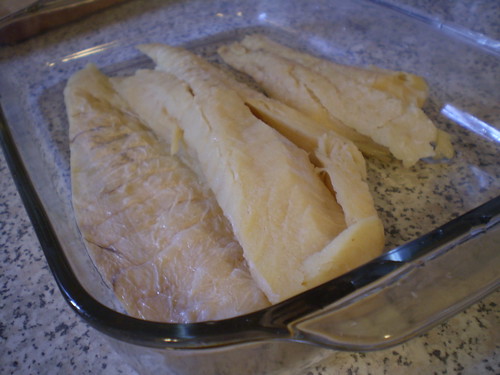
Bacalao, dried salted cod, is a Spanish staple, although it is eaten throughout European Mediterranean countries and parts of the Caribbean. I recall it being everywhere in Spain during the time I spent there back in college. I even recall seeing stores that specialized in it. It is economical and it should be on your radar. You can even store it in your cabinet, and it is a lot sexier than canned tuna. Although Atlantic cod is is severely over-fished, there are other more sustainable sources for cod, so you should check that your bacalao came from one of these sources (use this chart as your guide). The fish must be soaked in water for 24-36 hours before using it to reconstitute it and get rid of the salt coating.
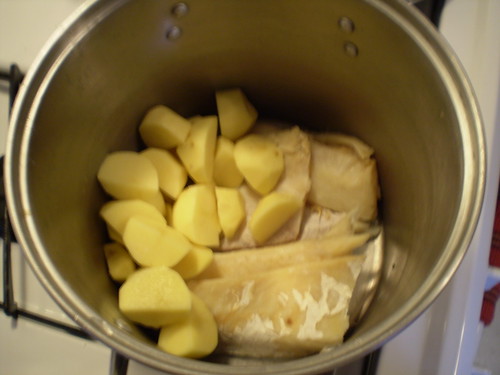
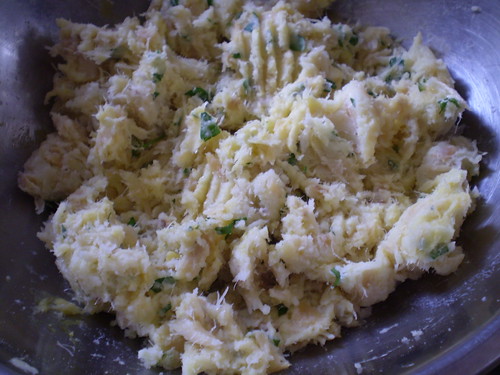
These fritters, are part potato and part cod. You cook the fish and the potato together first until the potato is soft enough to be mashed and then you flake the fish, taking care to remove any stray pin bones that may have been left. When combined with parsley and a bit of garlic and you have one tasty fried ball of goodness, well worthy of ringing in a new year with. They are traditionally served with aioli, which is a garlicky homemade mayonnaise sauce, if you weren't familiar with it. But really any spicy sauce would be delicious here. In a quick improvise last night I mixed an Asian chili sauce I had lying around with mayo and it got raves. Just make sure that if your eating garlic, so is the person you plan on kissing at midnight.

Feliz Año Nuevo and Happy New Year everyone!
Bacalao Fritters aka Buñuelos de Bacalao
Adapted from The Foods and Wines of Spain by Penelope Casas. Recipe can be easily doubled for a large crowd. Don't forget to start soaking the bacalao in advance!
1/2 lb. skinned and boned dried salt cod
1 lb. medium potatoes, peeled and quartered
2 garlic cloves, crushed
1 tablespoon flat leaf parsley, chopped
2 egg yolks
Oil for frying
Cover the cod with water and leave in the fridge to soak for 24-36 hours, changing the water a few times. Drain.
Place peeled potatoes and cod in a large pot. Cover with water and bring to a boil. Then cover the pot and let simmer for about 30 minutes or until potatoes are fork tender.
Drain the potatoes and cod. Set the fish aside to be crumbled (best done with your hands) and take care to look for any small pin bones left. Take the potatoes and pass through a fine sieve, or alternatively pass them through a food mill. Ideally, you want them to have a light and fluffy texture. Mix the potatoes and the cod with the remaining ingredients. Set mixture aside in the refrigerator for at least an hour before frying. The mixture keeps for about half a day max in the fridge, if you want to prep ahead.
Heat a heavy-bottomed pan with oil to fry the fritters in. Roll the mixture in your hands, like your making meatballs and then fry until golden brown. Keep them warm in a 200 degree oven until ready to serve.
Monday, December 21, 2009
Gingerbread Cookie Decorating Party

I love gingerbread. It is a holiday classic. It may not be inventive or cutting-edge, but not everything should be. The recipe I follow came from Bon Appetit's December 2006 issue. It is slightly spicy, with a deep brown-sugar and molasses flavor. It puts a twist on tradition by suggesting you flavor your icing with juniper berries. This part I could take or leave. I know there are a million and one gingerbread recipes out there, and every year I say I'm going to experiment with others, but for the last three years all those who have tried them seem to love them so that I haven't found a reason to mess with a good thing. I wanted to share this recipe with you in case your looking for a well-tested classic version.
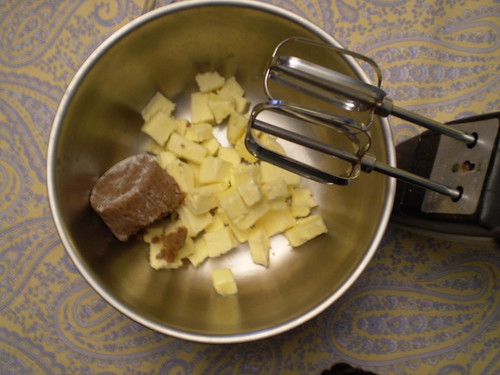
I normally make these cookies at least twice during the holiday season. The first batch always seems to disappear before being wrapped up and gifted out to friends and family. The only changes I've made to the original recipe are switching out light brown sugar for dark, and using unsulphured blackstrap molasses in place of regular. It's a subtle change that make for a more intense cookie. It is the perfect cookie to practice your decorating skills on (and I learned I could use a LOT more practice) and make into a snowy weekend project. This batch was made after a wonderful holiday brunch my cousin hosted during Hanukkah. It was too cute to see four people each measuring out different ingredients and generally buzzing around the table.
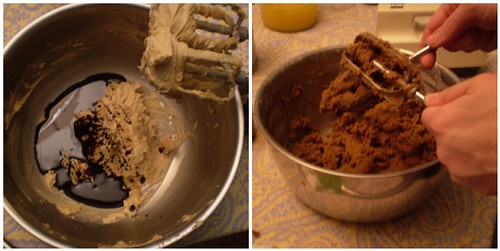
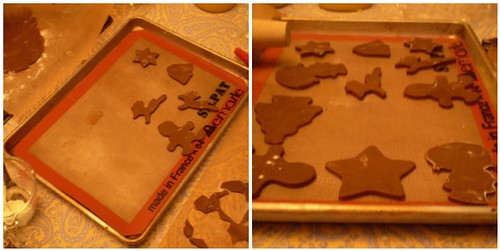
After the dough rested, we set up two separate rolling stations (photos at this point were getting a bit blurry after a few mimosas) and went to work lining up the cut out shapes on silpat or parchment-lined baking sheets. This would be perfect work for little kids, but the only kid we had on hand was still too little to help. Not that any of us big kids seemed to mind handling the task. These cookies bake up crisp, and the thinner you roll them out the crisper they will be. We went with about 1/4 inch thickness on the dough to have them be a bit more chewy. They also need to be carefully watched towards the end of the baking time, unless you don't mind them a bit well-done around the edges (I save those imperfect ones for myself).

Once they're baked, let them cool and prepare the royal icing to decorate as you wish. That's when the real fun comes in. This time around we skipped the juniper flavor used in the original recipe (of course if you want to give the juniper a try, find it here). We used lime juice in place of lemon juice for the royal icing, simply because we were out of lemons. But we all agreed the lime was a nice little twist that we would make again. We used Martha Stewart's royal icing recipe, and it was a very good thing.
Gingerbread Cookies
Adapted from Bon Appetit. See links above for two different icing options.
2 1/4 cups unbleached all purpose flour
1 teaspoon ground ginger
1 teaspoon ground allspice
1/2 teaspoon ground cinnamon
1/2 teaspoon baking soda
1/2 teaspoon salt
1 cup (2 sticks) unsalted butter, room temperature
1/2 cup (packed) dark brown sugar
1/4 cup blackstrap molasses
Whisk first 6 ingredients in medium bowl. Beat butter and sugar in large bowl until fluffy. Beat in molasses. Beat in dry ingredients. Gather dough; divide into 4 pieces. Shape into disks. Wrap; chill at least 2 hours and up to 2 days.
Preheat oven to 350°F. Line 2 baking sheets with parchment. Roll out 1 dough disk to 1/8-inch thickness. Using 3 1/2-inch cutter, cut out cookies. Transfer to sheet. Gather scraps; chill.
Bake cookies until almost firm in center, 12 minutes. Cool on sheets 2 minutes, then cool on racks. Repeat, using all dough.
Note: Cookies can be stored in an airtight container at room temperature up to 3 days or freeze up to 2 weeks.
Wednesday, December 16, 2009
Holiday Lace Cookies

You know these cookies. You've seen them in the cookies by the pound section of the bakery case. You've even eaten them before and loved them, most likely without knowing their name. They're an old-fashioned cookie, generally known as Lace Cookies because of their porous looking appearance. It appears there are lace cookie variations from one European country to another (like most cookies). French lace cookies were traditionally made with almonds, while Irish lace cookies were made with oatmeal and milk or cream, and German lace cookies are also oatmeal-based cookies, but with ginger, cloves and cinnamon added. My recipe came from the Fannie Farmer Cookbook, originally written to help bring some consistency to our young country, by creating recipes that were formulas. Fannie (as I like to call her) Americanized things in the process by removing any country of origin, and simply called them Lace Cookies. Additionally, many newer American versions today call for corn syrup, but I prefer to bake with butter when I can.
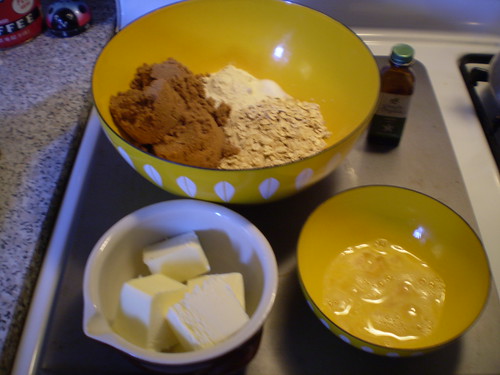
I'm entering this into the Share Our Strength, 12 Days of Sharing cookie jar. (A great cause, read more about it at In Jennie's Kitchen).This cookie recipe should be categorized under, Stupidly Simple, because it is. Mix dry ingredients in a bowl. Pour melted butter over it, then a beaten egg and some vanilla. Drop onto a cookie sheet and bake. Nothing more too it. It's the kind of recipe you'd be well-served committing to memory to whip up off the top of your head while visiting family, or away for the weekend skiing. The results would impress your onlookers and fool everyone into thinking your a culinary whiz in the kitchen. Sit back, smile, and think, "Ha, ha."
There's only a few tricks to know how to pull this recipe off without a hitch. First, you must must space the cookies at least 1 1/2 inches to 2 inches apart, depending on the size of your cookies. Second, you should stay close to the oven while these babies are baking. They go from well-done to slightly burnt quickly. My suggestion is to keep the oven light on (if you have one) and keep an eye on them after they've been in there for 3 minutes. Plus, it's fun to watch the cookies bubble away and bake. Third, you really must use some patience and give them a few minutes to cool before you try to move them off the cookie sheet. If you slide your spatula under one while it is still hot it will squish into the middle and resemble a piece of caramel. That is an irreversible error. Obviously it will still taste good, but baked goods should also look good too.


This being a holiday cookie, you should consider some options to gussy up your cookie creation. Consider shaping the cookies into a tuille by bending them around the handle of a wooden spoon while still warm (not hot). Then let them cool in that shape. This is a pretty example of how a tuille shape makes a more impressive presentation. My personal favorite is the way I had them as a kid, where the bottom is coated with melted chocolate. Yum. And, coating things with chocolate seems like a good task to include the kiddies in on. (Personally, I wish someone had let me do that as a kid, rather than play with a dreidel. I'm just saying.)

Holiday Lace Cookies
Adapted from The Fannie Farmer Cookbook
1 1/2 cups uncooked oatmeal (not anything instant or quick-cooking)
1 1/4 cups brown sugar
2 tablespoons flour
1/2 teaspoon salt
2/3 cup (about 10 tablespoons) melted butter
1 egg, lightly beaten
1/2 teaspoon vanilla
Preheat the oven to 350 degrees Fahrenheit.
Mix the dry ingredients together in a big bowl. Melt the butter. Add to the
dry ingredients and mix to combine. Add the egg and the vanilla and mix until
all incorporated.
Line a baking sheet with a silpat or parchment paper. Drop cookies about
1/2-1 teaspoon at a time onto cooking sheet. Take care to keep them spaced about
2 inches apart. They will look small but will spread as they bake.
Bake in the oven for 5 minutes or until firm. Watch them closely after 3
minutes, depending on how well done you want them. Let cookies cool on the
baking sheet for a few minutes before you touch them. Carefully, using a
spatula lift off baking sheet to cool completely.
Monday, December 14, 2009
Fourth-Night-Hanukkah-Huevos
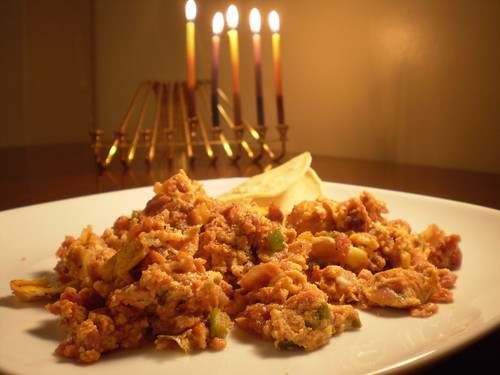
I did some Hanukkah food research today, and to my surprise there are two schools of thought. One belief is that holiday foods must be fried, while others merely require the food be cooked with olive oil. The holiday foods I grew up with were always fried, so I assumed that is what they needed to be. But after consulting with the all-knowing, all-seeing internets, I realized that there are sources out there that do not feel the frying aspect is necessary. Despite fried food's deliciousness, I decided that I don't need to celebrate this particular miracle from thousands of years ago with trying to create my own miracle (namely not gaining a pants size or clogged arteries from eating fried food for 8 days). I'm going with the more sensible, "cooked with olive oil" tradition.
With that cleared up, I proceeded with a quick light supper (borrowed from my brunch repertoire) of Huevos a la Mexicana. It is basically eggs scrambled with the colors of the Mexican flag, green (chiles), white (onions), and red (tomatoes). It is another one of these modest dishes where a few very ordinary ingredients combine to make a fine meal. I always serve these egss with small corn tortillas for a more authentic flavor then the supermarket flour type.
Cook the onions in miraculous wonderful olive oil until translucent, then add the chiles (leave the ribs on for a spicier version), and the tomatoes. Cook for about 5 minutes until some of the juice from the tomatoes renderss out a bit, and the chile is no longer raw. Then pour in some beaten eggs and mix it altogether. Cover and let the eggs set. That's it, nothing fancy. Although this is not holiday fare to serve your relatives, it is technically within keeping with the tradition. It will allow you to bravely plough through one of the eight days without feeling remorse for subsisting on fried food and holiday cookies for the next week (or two). Viva la revolución!
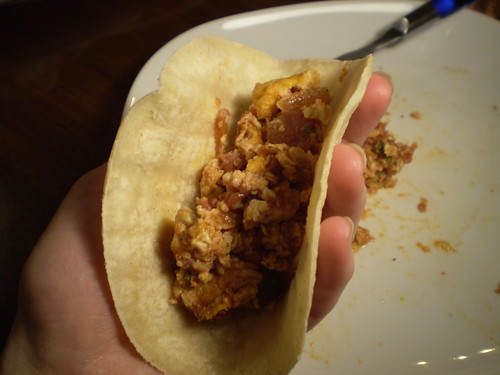
Hanukkah Huevos (a la Mexicana)
Adapted from Mexico, The Beautiful Cookbook.
2 tablespoons olive oil
1/4-1/2 onion, chopped
2 chiles, finely diced (serrano or jalapeno)
1 tomato chopped (or about 3/4 cup of diced canned tomatoes)
salt
3-4 eggs, lightly beaten
Heat the oil in a skillet. Add the onion and saute until transparent. Add the chiles, tomato, and salt and cook over medium heat for about 5 minutes. Add the beaten eggs to the pan and stir to incorporate. Cover and cook for 2-3 minutes or until eggs are set. Break up with a wooden spoon once done. Serve with warm corn tortillas.
Friday, December 11, 2009
First-Night-Carciofi-alla-Judea
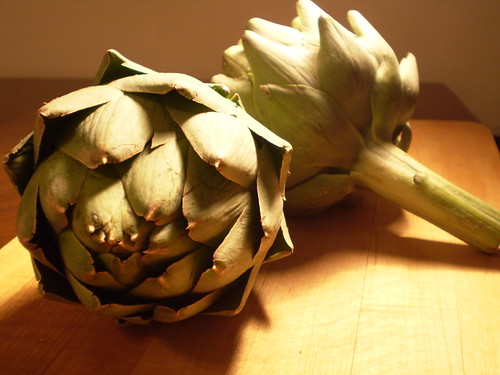
Hanukkah may have some traditional foods, potato latkes (aka potato pancakes) and sufganiyot (aka jelly doughnuts), but in general the rule is anything fried goes. So, while shopping for potatoes to make latkes, I changed my plans when I saw these striking artichokes in the market. I had to have them. They were beautiful and festive, perfect for a holiday meal. Next, I set out to think about what I could do with artichokes for the first night of Hanukkah. I recalled reading about a fried artichoke preparation that originated in the Jewish ghetto of Rome, simply called Carciofi alla Judea (for more about the history of this dish click here). I have never had one of these prepared for me, but I thought, "how could anything fried taste bad?" Unfortunately, there was nothing miraculous about this meal, except for the amount of olive oil I wasted.
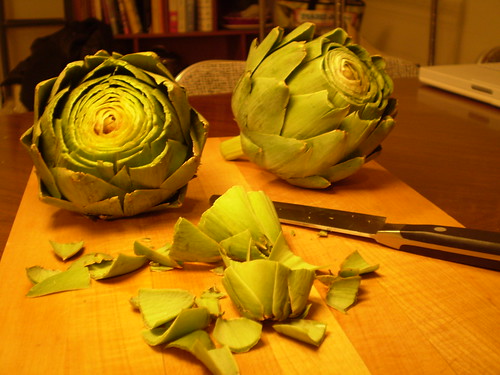
I jumped on this idea, lured by images of lightly browned, crunchy, earthy artichoke petals that would impress you and inspire you to put down the potatoes and fry something different. I didn't do my research. If I had I would have seen that this dish is best prepared with baby artichokes, for their more tender leaves. I might also have realized that frying them whole was an option, as used in some other versions of this recipe.
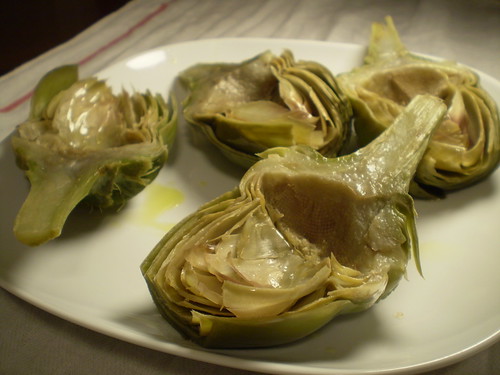
The recipe that I found and put my faith in (it was on a great Jewish blog after all) called for peeling off the tough outer leaves and slicing the artichoke in half before you start on the two-step process of cooking them in a mixture of olive oil and water until softened (see the photo above), and then frying them until crispy.
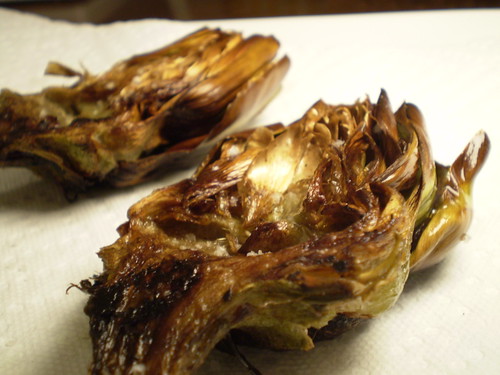
My artichokes looked like fried goodness, glistening as they came out of the olive oil. After a sprinkle of some fleur de sel salt and a squeeze of lemon I could barely wait to grab a piece. I started with the outer leaves that looked more well-done, hoping that it would taste like a crispy french fry. Not exactly. The tops of the leaves were tough and difficult to chew, if not near impossible. "Ok", I thought, not giving up hope, "the inside leaves will be better". They were better, but not great. In the end, I resorted to eating the leaves as if they were steamed, scraping the tender bottom part off and discarding the rest of the leaf. We agreed that it seemed like a waste and definitely not the intended result.
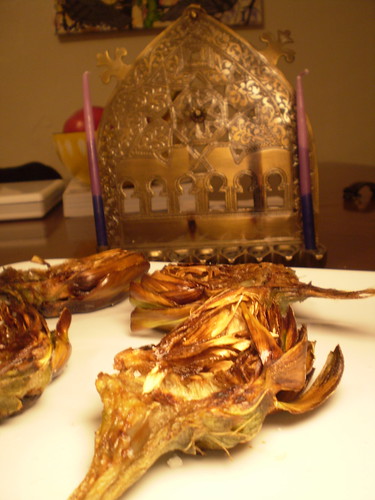
The one saving grace of this dish was the artichoke heart. I guess that's why I couldn't be too upset. It was tender and a bit smoky tasting from the oil. It was definitely good eating, especially with a bit more salt. I'm sure my inexperience in making these was to blame for the flawed result. However, I bet they could be spectacular when done correctly, so please do not let that discourage you from trying this dish (just make sure to get baby artichokes). And, the best part of Hanukkah, there are 7 more nights to fry things and get them right.
Carciofi alla Giudia
Reprinted from The Jew and the Carrot (http://www.jcarrot.org)
4 medium sized artichokes (look for vegetables with soft, long, flexible stems)
1 lemon
Plenty of olive oil
Sea salt to taste
Fill a large bowl with water and the juice of one lemon. Working one artichoke at a time, trim the stem to 1 1/2 – 2 inches. Using a vegetable peeler, remove the outer dark green layer of the stem, revealing the softer, lighter green center. Cut off the artichoke’s thorny top (horizontally) using a serrated knife and then carefully slice the artichoke in half, (vertically).
Remove the artichoke’s tough outer leaves until only the soft inner leaves remain. Using a small spoon, remove the hairy “choke” at the center of each artichoke half. (It may seem like you are wasting a lot of the plant –which is kind of true. Assuage your guilt by composting them!)
At this point, open your windows and turn on a fan!
Fry #1: Select a pot that is large enough to comfortably hold all of the artichoke halves. Place them in the pot, fill with oil until chokes are half covered. Then add water to cover. Bring pot to a simmer and cook, uncovered, about 15 minutes until they are cooked but not too soft. Remove with tongs and place on a platter.
Fry #2: Heat about one inch of oil in a cast iron pan (or other heavy pan). Using a pair of tongs, and lots of care, place the choke halves side down in the oil. Be really careful–hot oil splatters and hurts.
Fry for about 12 minutes, flipping the chokes halfway through, until brown and crispy on both sides. Turn off the heat and remove the fried chokes with tongs. Place onto paper towels to drain. Sprinkle with salt and serve warm.







